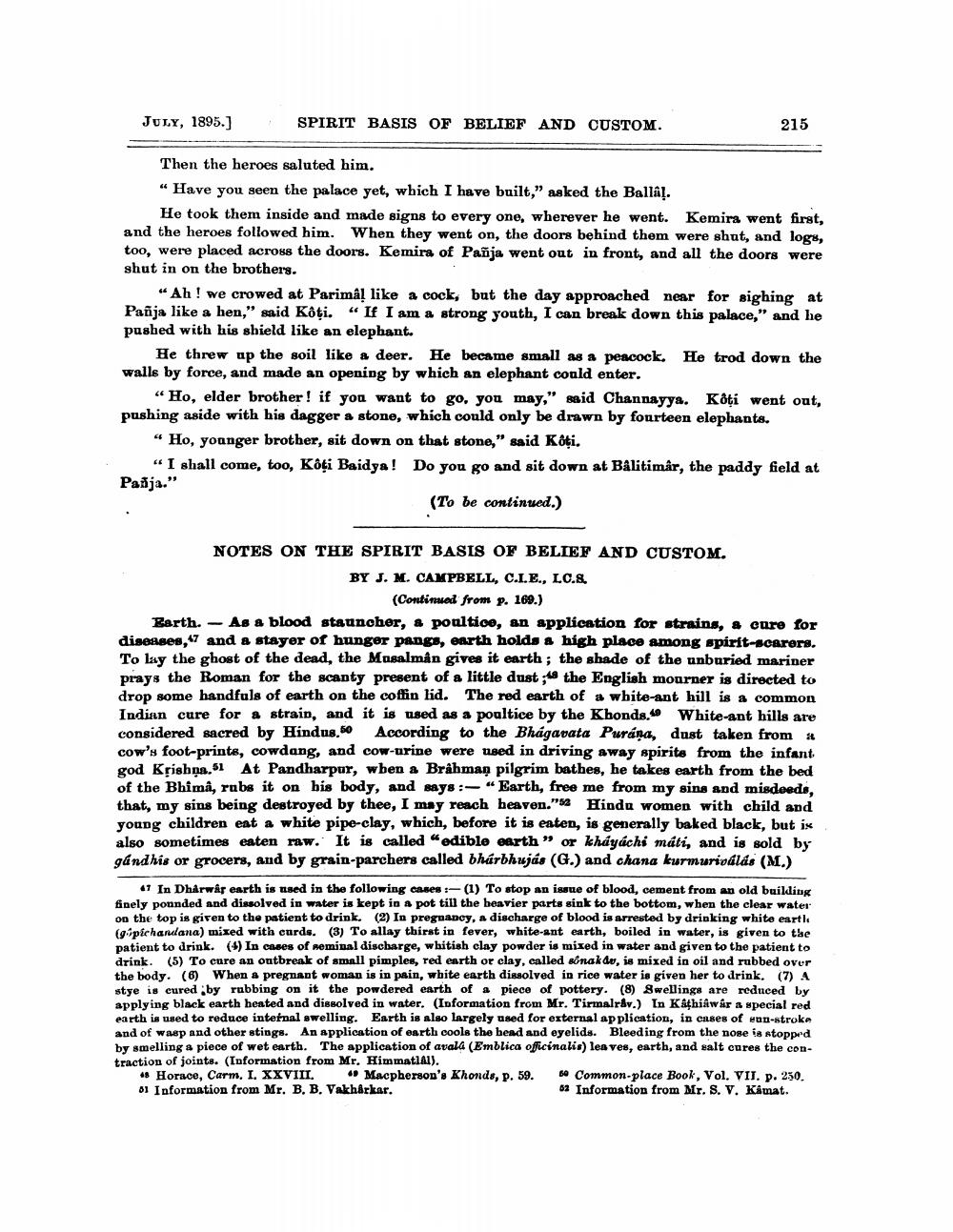________________
JULY, 1895.]
SPIRIT BASIS OF BELIEF AND CUSTOM.
215
Then the heroes saluted him. “Have you seen the palace yet, which I have built," asked the Balla!.
He took them inside and made signs to every one, wherever he went. Kemira went first, and the heroes followed him. When they went on, the doors behind them were shut, and logs, too, were placed across the doors. Kemira of Pañja went out in front, and all the doors were shut in on the brothers.
“Ah! we crowed at Parimal like a cock, but the day approached near for sighing at Pañja like a hen," said Kôţi. "If I am a strong youth, I can break down this palace," and he pushed with his shield like an elephant.
He threw ap the soil like a deer. He became small as a peacock. He trod down the walls by force, and made an opening by which an elephant could enter.
“Ho, elder brother! if you want to go, you may," said Channayya. Kôti went out, pushing aside with his dagger a stone, which could only be drawn by fourteen elephants.
“ Ho, younger brother, sit down on that stone," said Koti.
"I shall come, too, Koţi Baidya! Do you go and sit down at Balitimâr, the paddy field at Padja."
(To be continued.)
NOTES ON THE SPIRIT BASIS OF BELIEF AND CUSTOM.
BY J. M. CAMPBELL, C.I.E., LC.S.
(Continued from p. 169.) Barth. As a blood stauncher, & poultice, an application for strains, & cure for diseases, and a stayer of hunger pangs, earth holds a high place among spirit-scarers. To lay the ghost of the dead, the Musalman gives it earth; the shade of the unburied mariner prays the Roman for the scanty present of a little dust, the English moarner is directed to drop some handfuls of earth on the coffin lid. The red earth of a white-ant hill is a common Indian cure for a strain, and it is used as a poultice by the Khonds. White-ant hills are considered sacred by Hindus. According to the Bhagavata Purána, dust taken from * Cow's foot-prints, cowdang, and cow-urine were used in driving away spirits from the infant god Krishna 51 At Pandharpur, wben a Brâhman pilgrim bathes, he takes earth from the bed of the Bhima, rubs it on his body, and says :- "Earth, free me from my sins and misdeeds, that, my sins being destroyed by thee, I may reach heaven." Hindu women with child and young children eat a white pipe-clay, which, before it is enten, is generally baked black, but is also sometimes eaten raw. It is called "edible earth” or kháyáchi máti, and is sold by gánd his or grocers, and by grain-parchers called bhárbhujás (G.) and chana kurmuriválás (M.)
17 In Dharwas earth is used in the following cases :-(1) To stop an issue of blood, cement from an old building finely ponnded and dissolved in water is kept in pot till the beavier parts sink to the bottom, when the clear water on the top is given to the patient to drink. (2) In pregnancy, a discharge of blood is arrested by drinking white earth (gipichandana) mixed with cards. (3) To allay thirst in fever, white-ant earth, boiled in water, is given to the patient to drink. (4) In cases of seminal discharge, whitish clay powder is mixed in water and given to the patient to drink. (5) To cure an outbreak of small pimples, red earth or clay, called sinakde, is mixed in oil and rubbed over the body. (6) When a pregnant woman is in pain, wbite earth dissolved in rice water is given her to drink. (7) A stye is cured by rubbing on it the powdered earth of a piece of pottery. (8) Swellings are reduced by applying black earth heated and dissolved in water. (Information from Mr. Tirmalrav.) In Kithiwr a special red earth is used to reduce internal swelling. Earth is also largely used for external application, in cases of un-stroke and of wasp and other stings. An application of earth cools the bead and eyelids. Bleeding from the nose la Atopped by smelling a piece of wet earth. The application of avald (Emblica officinalis) leaves, earth, and salt cures the contraction of joints. (Information from Mr. Himmatlal).
• Horace, Carm. I. XXVIII. Macpherson's Khonds, P. 59. Common place Book, Vol. VII. p. 250. 01 Information from Mr. B. B. Vakhårkar.
61 Information from Mr. S. V. Kámat.




